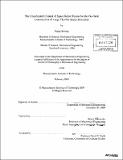The coordinated control of space robot teams for the on-orbit construction of large flexible space structures
Author(s)
Boning, Peggy
DownloadFull printable version (41.71Mb)
Other Contributors
Massachusetts Institute of Technology. Dept. of Mechanical Engineering.
Advisor
Steven Dubowsky.
Terms of use
Metadata
Show full item recordAbstract
Teams of autonomous space robots are needed for future space missions such as the construction of large solar power stations and large space telescopes in earth orbit. This work focuses on the control of teams of robots performing construction tasks such as manipulation and assembly of large space structures. The control of the robot structure system is difficult. The space structures are flexible and there are significant dynamic interactions between the robots and the structures. Forces applied by the robots may excite undesirable vibrations in the structures. Furthermore, the changing configuration of the system results in the system dynamics being described by a set of non-linear partial differential equations. Limited sensing and actuation in space present additional challenges. The approach proposed here is to transform the system dynamics into a set of linear time-varying ordinary differential equations. The control of the high-frequency robots can be decoupled from the control of the low-frequency structures. This approach allows the robots to apply forces to the structures and control the dynamic interactions between the structures and the robots. The approach permits linear optimal control theory to be used. Simulation studies and experimental verification demonstrate the validity of the approach.
Description
Thesis (Ph. D.)--Massachusetts Institute of Technology, Dept. of Mechanical Engineering, 2009. Includes bibliographical references (leaves 95-103).
Date issued
2009Department
Massachusetts Institute of Technology. Department of Mechanical EngineeringPublisher
Massachusetts Institute of Technology
Keywords
Mechanical Engineering.